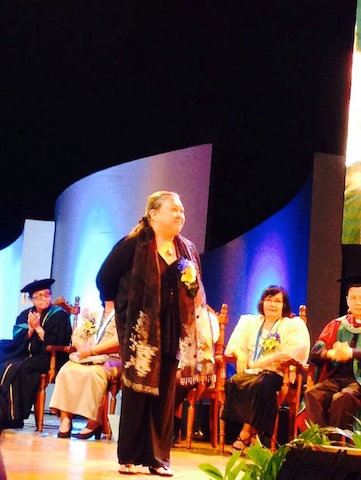Agnes Locsin is 6th National Artist for Dance, 6th Mindanawon National Artist
DAVAO CITY (MindaNews / 11 June) – Dance icon Agnes Dakudao Locsin of Davao City is among eight National Artists for 2022 named by President Rodrigo Duterte through Proclamation 1390 on Friday.
Locsin, National Artist for Dance, is the sixth artist in that category since 1973 and the sixth Mindanawon to be named National Artist after Victorio Edades (Painting, 1976), Leonor Orosa Goquingco (Dance, 1976), Ang Kiukok (Visual Arts, 2001), Abdulmari Asia Imao (Visual Arts, 2006) and Resil Mojares (Literature, 2018).

The seven other National Artists for 2022 are actress-singer Nora Cabaltera Villamayor, more popularly known as Nora Aunor, for Cinema; soprano Fides Cuyugan-Asensio for Music; screenwriter and novelist Ricky Lee and poet Gemino Abad for Literature. Three were proclaimed National Artists posthumously: movie director Marilou Diaz-Abaya for Cinema; stage director and theater actor Tony Mabesa for Theater and Salvacion Lim Higgins for Fashion. Abaya passed away in October 2012, Mabesa in October 2019 and Higgins in 1990.
The Order of National Artists (Orden ng mga Pambansang Alagad ng Sining) is the highest national recognition given to Filipino individuals who have made significant contributions to the development of Philippine arts — Music, Dance, Theater, Visual Arts, Literature, Film, Broadcast Arts, and Architecture and Allied Arts.
The order is jointly administered by the National Commission for Culture and the Arts and the Cultural Center of the Philippines and conferred by the President of the Philippines upon recommendation by both institutions.
Proclamation 1390 noted that the works and achievements of the 64-year old Locsin in the field of dance “spurred a growing interest in neo-ethnic style among young artists.”
Mindanawon National Artists
In the 50-year history of awarding National Artists, six Mindanawons have made it to the list.
Like Locsin, Ang Kiukok was a Dabawenyo, and so was Edades, dubbed “father of modern Philippine Art.” Born in Davao City in 1931, Ang Kiukok passed away in 2005 in Quezon City while Edades, who was born in Dagupan in1895, retired in Davao City where he died in 1985.
Born in Polanco, Zamboanga del Norte, Mojares is now based in Cebu City.
Goquinco, described as “Trailblazer,” “Mother of Philippine Theater Dance” and “Dean of Filipino Performing Arts Critics,” was born in Jolo, Sulu in 1917. She passed away in 2005. Her father, Dr. Sixto Y. Orosa, who served as District Health Officer of Sulu and Supervising Physician at the Sulu Public Hospital, wrote the book “Sulu Archipelago and its People,” which was published by the World Book Company in New York in 1931.
Imao, who was born in Siasi, Sulu in 1936, passed away in December 2014. He was the first Moro to be named National Artist.
Born in Davao City on September 28, 1957, Locsin spent her elementary and high school years at the Philippine Women’s University here and finished AB English at the Ateneo de Davao University. She earned her MA in Dance at the Ohio State University.
As a student at the Ateneo de Davao in the late 1970s, Locsin collaborated with artists Joey Ayala and Al Santos for the rock opera, “Sa Bundok ng Apo,” where she did the choreography for Santos’ lyrics and Ayala’s music. They would collaborate again in “Encantada.”
In 2014, Locsin and fellow Mindanawon Cardinal Orlando Quevedo, were among six exemplars honored by the Ateneo de Manila University (ADMU). The university conferred on “Missionary and Peace-builder” Quevedo the Bukas Palad Award and on “Pioneer of neo-ethnic Filipino dance” Locsin, the Gawad Tanglaw ng Lahi.
“Neo-ethnic”
According to the ADMU citation, Locsin, one of the country’s most progressive contemporary dance choreographers, “pioneered neo-ethnic dance by blending indigenous themes with Western classical and modern techniques.” The citation described Locsin as “always open to new and innovative approaches” and who collaborated with musicians, visual artists and poets in the creation of her original choreographies, among them Encantada, La Revolucion Filipina, Sayaw, Sabel and the four-part Alay sa Puno series.

The ADMU said in 2014 that Locsin “created a body of work which proudly celebrates Filipino indigenous cultures, practices, beliefs, rituals and lore, contributing to our own appreciation of the complexity of our culture and identity.”
Before Locsin, five others had been named National Artist for Dance: Francisca Reyes Aquino (1973), Ramon Obusan (2006), Alice Reyes (2014), Leonor Orosa Goquingco (1976) and Lucrecia Reyes-Urtula (1988).
According to the ONA (Order of National Artists) Guidelines approved on April 27, 2017 during the NCCA Board of Commissioners Meeting, the honors and privileges accorded a National Artist are: the rank and title of National Artist, as proclaimed by the President of the Philippines; the National Artist gold-plated medallion minted by the Bangko Sentral ng Pilipinas (BSP) and citation; a lifetime emolument and material and physical benefits comparable in value to those received by the highest officers of the land such as: a minimum cash award of 200,000 pesos net of taxes; a minimum lifetime personal monthly stipend of 50,000 pesos; medical and hospitalization benefits not exceeding 750,000 a year; coverage by a life insurance policy by the Government Service Insurance System (GSIS) and or/ private insurance companies from date of conferment the award, in the event that the National Artist is insurable, the premiums for which shall be paid by the National Government or by donation from any governmental or private entities.
National Artists are given a place of honor, in line with protocular precedence, in state functions, national commemoration ceremonies and all other cultural presentations.
They are also entitled to a state funeral, the arrangements for and the expenses of which shall be borne by the Government, and (Carolyn O. Arguillas / MindaNews)



No comments:
Post a Comment